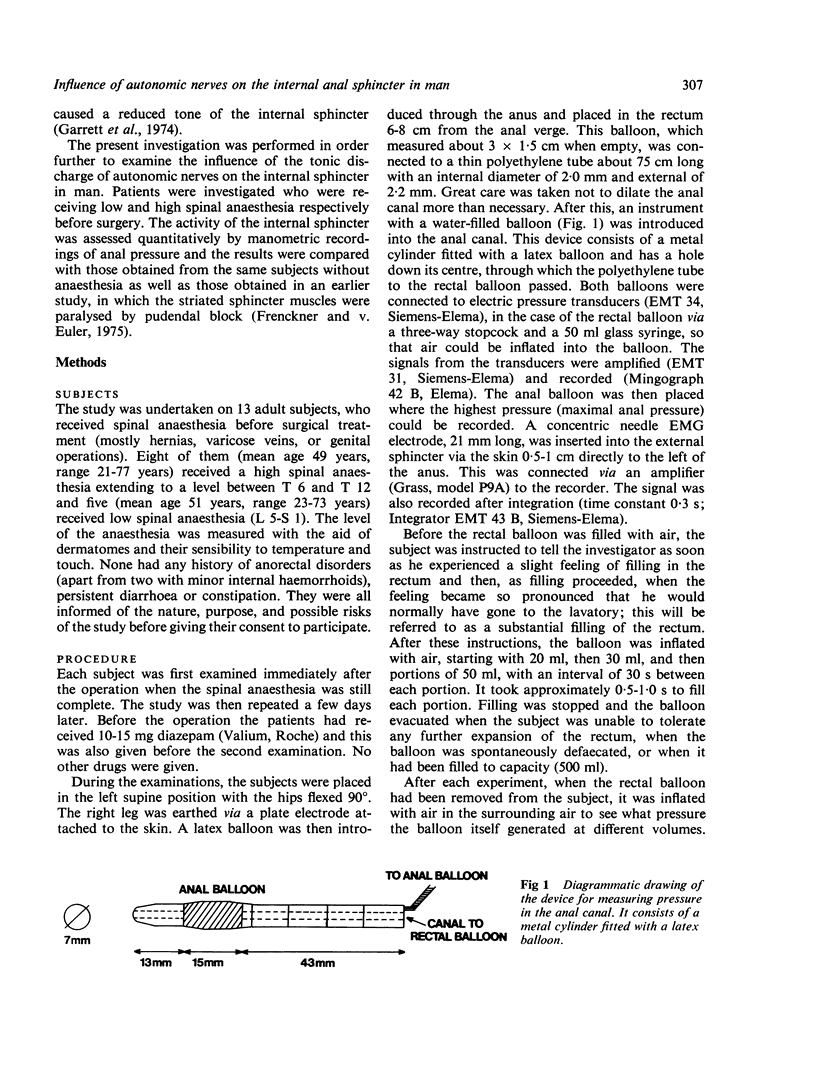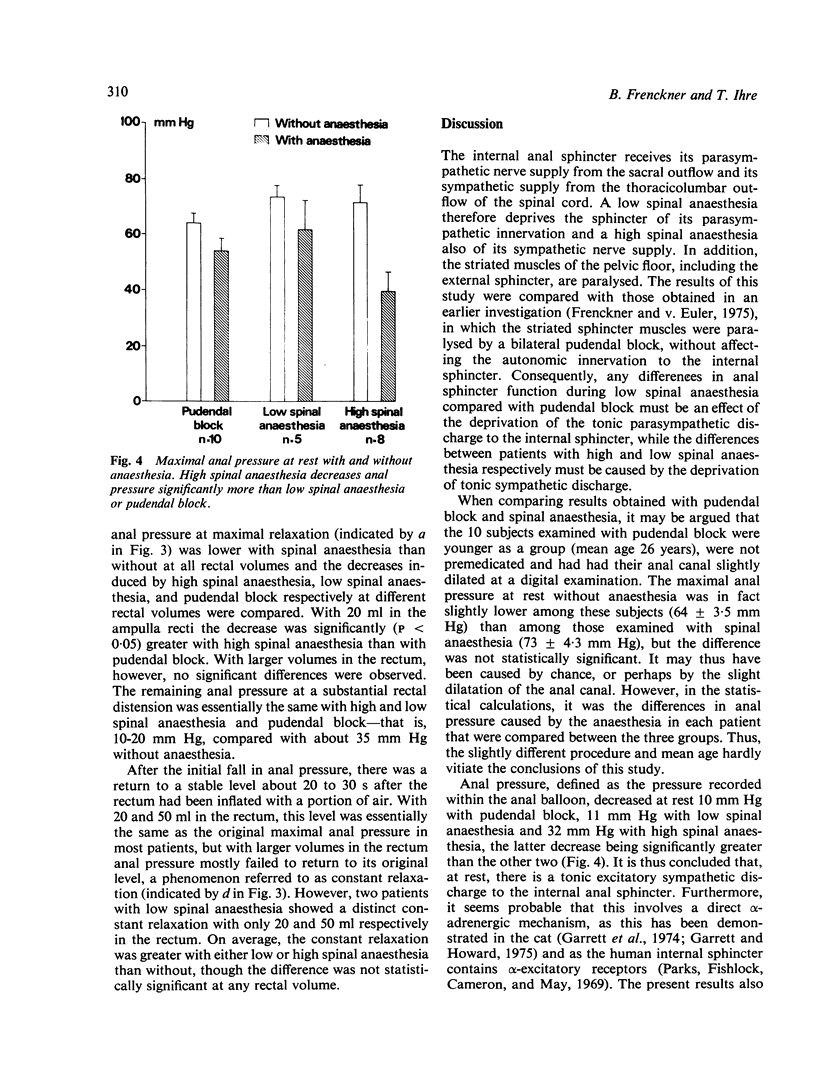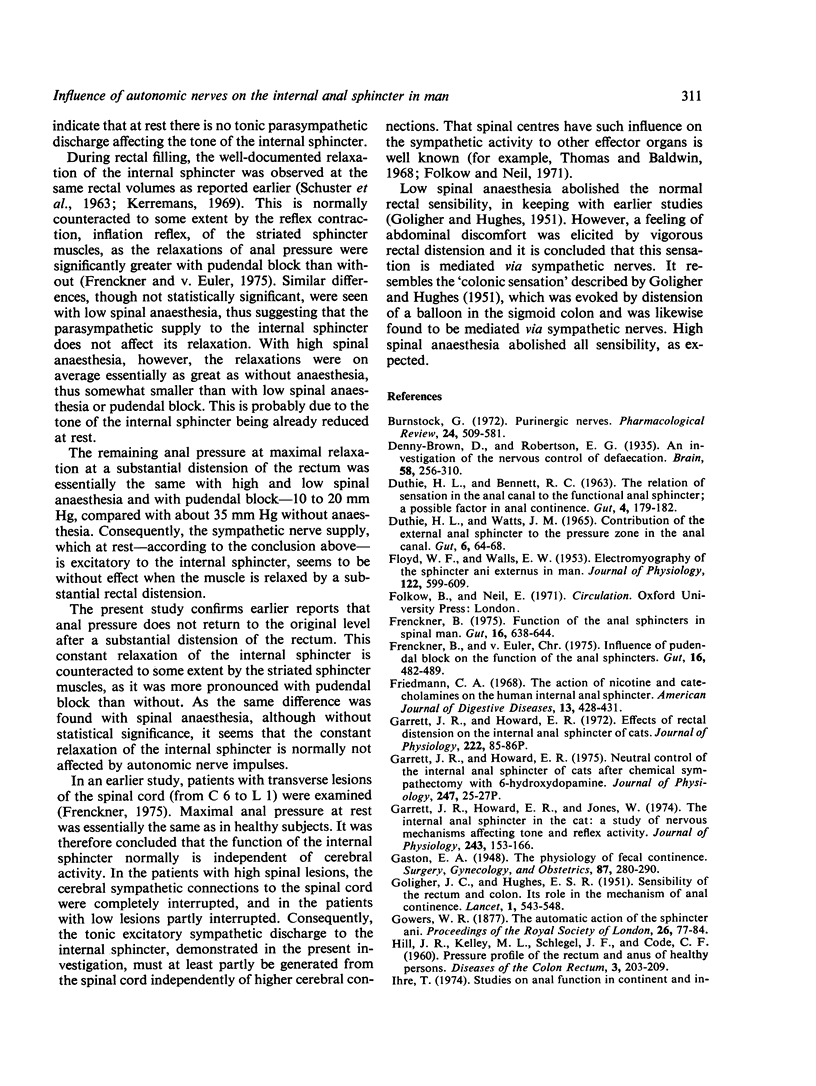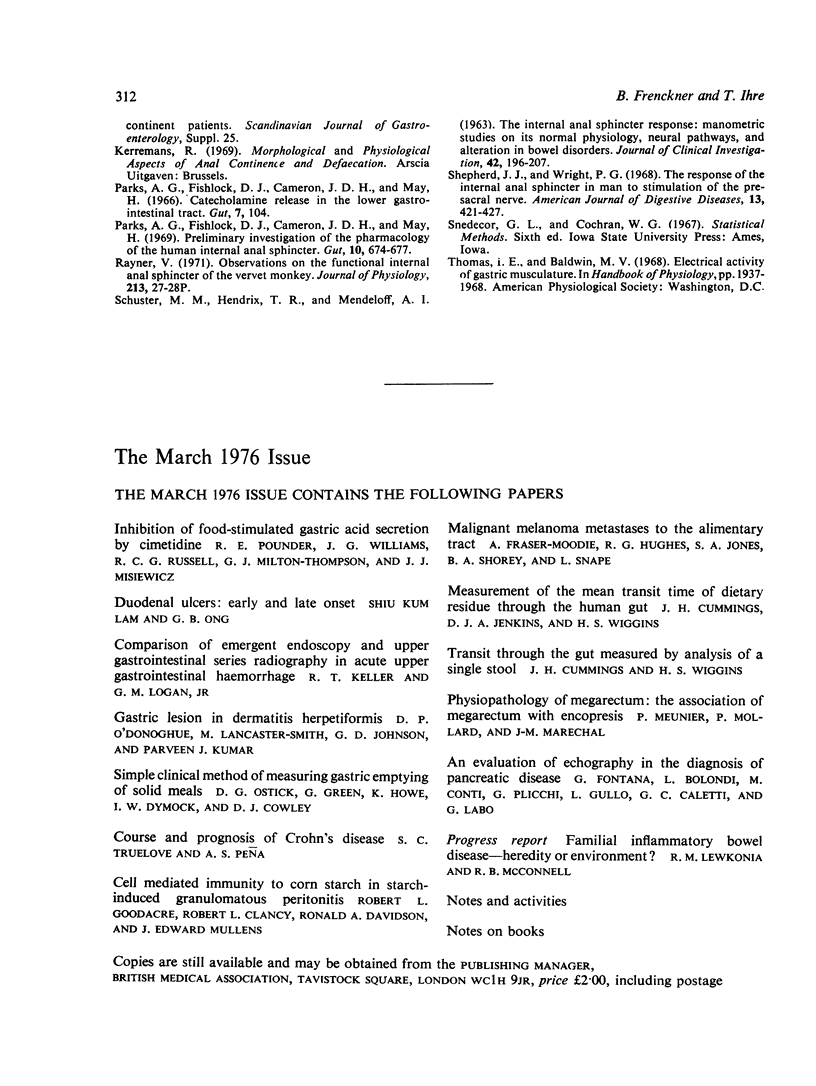Abstract
The internal and sphincter receives its parasympathetic nerve supply from the sacral outflow and its sympathetic supply from the thoracicolumbar outflow of the spinal cord. In order to investigate the influence of the tonic discharge of these nerves, eight healthy subjects receiving high spinal anaesthesia (T 6-T 12) and five receiving low spinal anaesthesia (L 5-S 1) were examined. Continuous recordings of anal pressure and electromyographic activity from the external sphincter were obtained during rest and during expansion of the ampulla recti by means of an air-filled balloon. The results were compared with those obtained in an earlier study from 10 subjects with a bilateral pudendal block which paralysed the striated sphincter muscles without affecting the autonomic nerve supply to the internal sphincter. Anal pressure at rest decreased significantly more with high spinal anaesthesia (32 +/- 3-2 mm Hg) than with low (11 +/- 7-1 mm Hg) or with pudendal block (10 +/- 3-9 mm Hg) and the relaxations of the internal sphincter induced by rectal distension were somewhat smaller with high spinal anaesthesia. However, the remaining anal pressure at maximal relaxation, induced by a substantial rectal distension, was essentially the same with the three forms of anaesthesia. It is concluded that, at rest, there is a tonic excitatory sympathetic discharge to the internal anal sphincter in man. However, this seems to be without excitatory effect when the sphincter is relaxed after a substantial rectal distension. Furthermore, the results indicate that at rest there is no tonic parasympathetic discharge affecting the sphincter tone.
Full text
PDF






Images in this article
Selected References
These references are in PubMed. This may not be the complete list of references from this article.
- Burnstock G. Purinergic nerves. Pharmacol Rev. 1972 Sep;24(3):509–581. [PubMed] [Google Scholar]
- DUTHIE H. L., WATTS J. M. CONTRIBUTION OF THE EXTERNAL ANAL SPHINCTER TO THE PRESSURE ZONE IN THE ANAL CANAL. Gut. 1965 Feb;6:64–68. doi: 10.1136/gut.6.1.64. [DOI] [PMC free article] [PubMed] [Google Scholar]
- Duthie H. L., Bennett R. C. The relation of sensation in the anal canal to the functional anal sphincter: a possible factor in anal continence. Gut. 1963 Jun;4(2):179–182. doi: 10.1136/gut.4.2.179. [DOI] [PMC free article] [PubMed] [Google Scholar]
- FLOYD W. F., WALLS E. W. Electromyography of the sphincter ani externus in man. J Physiol. 1953 Dec 29;122(3):599–609. doi: 10.1113/jphysiol.1953.sp005024. [DOI] [PMC free article] [PubMed] [Google Scholar]
- Frenckner B., Euler C. V. Influence of pudendal block on the function of the anal sphincters. Gut. 1975 Jun;16(6):482–489. doi: 10.1136/gut.16.6.482. [DOI] [PMC free article] [PubMed] [Google Scholar]
- Frenckner B. Function of the anal sphincters in spinal man. Gut. 1975 Aug;16(8):638–644. doi: 10.1136/gut.16.8.638. [DOI] [PMC free article] [PubMed] [Google Scholar]
- Friedmann C. A. The action of nicotine and catecholamines on the human internal anal sphincter. Am J Dig Dis. 1968 May;13(5):428–431. doi: 10.1007/BF02233663. [DOI] [PubMed] [Google Scholar]
- GOLIGHER J. C., HUGHES E. S. R. Sensibility of the rectum and colon. Its rôle in the mechanism of anal continence. Lancet. 1951 Mar 10;1(6654):543–547. doi: 10.1016/s0140-6736(51)92242-8. [DOI] [PubMed] [Google Scholar]
- Garrett J. R., Howard E. R. Effects of rectal distension on the internal anal sphincter of cats. J Physiol. 1972 Apr;222(1):85P–86P. [PubMed] [Google Scholar]
- Garrett J. R., Howard E. R., Jones W. The internal anal sphincter in the cat: a study of nervous mechanisms affecting tone and reflex activity. J Physiol. 1974 Nov;243(1):153–166. doi: 10.1113/jphysiol.1974.sp010747. [DOI] [PMC free article] [PubMed] [Google Scholar]
- Garrett J. R., Howard E. R. Neural control of the internal anal sphincter of cats after chemical sympathectomy with 6-hydroxydopamine. J Physiol. 1975 May;247(1):25P–27P. [PubMed] [Google Scholar]
- HILL J. R., KELLEY M. L., Jr, SCHLEGEL J. F., CODE C. F. Pressure profile of the rectum and anus of healthy persons. Dis Colon Rectum. 1960 May-Jun;3:203–209. doi: 10.1007/BF02616555. [DOI] [PubMed] [Google Scholar]
- Parks A. G., Fishlock D. J., Cameron J. D., May H. Preiminary investigation of the pharmacology of the human internal anal sphincter. Gut. 1969 Aug;10(8):674–677. doi: 10.1136/gut.10.8.674. [DOI] [PMC free article] [PubMed] [Google Scholar]
- Rayner V. Observations on the functional internal anal sphincter of the vervet monkey. J Physiol. 1971 Mar;213(2):27P–28P. [PubMed] [Google Scholar]
- SCHUSTER M. M., HENDRIX T. R., MENDELOFF A. I. The internal anal sphincter response: manometric studies on its normal physiology, neural pathways, and alteration in bowel disorders. J Clin Invest. 1963 Feb;42:196–207. doi: 10.1172/JCI104706. [DOI] [PMC free article] [PubMed] [Google Scholar]
- Shepherd J. J., Wright P. G. The response of the internal anal sphincter in man to stimulation of the presacral nerve. Am J Dig Dis. 1968 May;13(5):421–427. doi: 10.1007/BF02233661. [DOI] [PubMed] [Google Scholar]




